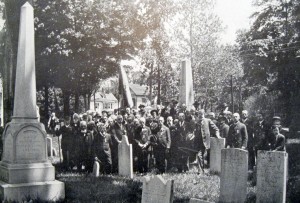
Civil War vets from Buckingham Post 12 at their c. 1900 Memorial Day observance at St. Paul's Churchyard, Norwalk, Connecticut. In the background is the grave of Lt.Col. Albert H. Wilcoxson, killed in 1865.
Thomas Bailey Aldrich (born Nov. 11, 1836, Portsmouth, N.H., died March 19, 1907) was a 19th century writer and editor who is known to some, at least, as the father of the American novel. His 1869 The Story of a Bad Boy is considered to be the inspiration for Mark Twain’s Tom Sawyer. Aldrich did not fight in the Civil War (most of the biographical sketches of Aldrich’s life say he wanted to enlist but did not) but instead became a war correspondent for the New York Tribune for a short while. Late in his life Aldrich penned an essay on Decoration Day, as Memorial Day was then known, that appears in snippets and quotes repeatedly but rarely in it’s entirety.
In honor of the dead of the 17th Connecticut, and for all soldiers of the U.S. Armed Forces who have given their lives for this country, here is the full text of Thomas Bailey Aldrich’s Decoration Day:
HOW quickly Nature takes possession of a deserted battlefield, and goes to work repairing the ravages of man! With invisible magic hand she smooths the rough earthworks, fills the rifle-pits with delicate flowers, and wraps the splintered tree-trunks with her fluent drapery of tendrils. Soon the whole sharp outline of the spot is lost in unremembering grass. Where the deadly rifle-ball whistled through the foliage, the robin or the thrush pipes its tremulous note; and where the menacing shell described its curve through the air, a harmless crow flies in circles. Season after season the gentle work goes on, healing the wounds and rents made by the merciless enginery of war, until at last the once hotly contested battleground differs from none of its quiet surroundings, except, perhaps, that here the flowers take a richer tint and the grasses a deeper emerald.
It is thus the battle lines may be obliterated by Time, but there are left other and more lasting relics of the struggle. That dinted army sabre, with a bit of faded crepe knotted at its hilt, which hangs over the mantel-piece of the “best room” of many a town and country house in these States, is one; and the graven headstone of the fallen hero is another. The old swords will be treasured and handed down from generation to generation as priceless heirlooms, and with them, let us trust, will be cherished the custom of dressing with annual flowers the resting-places of those who fell during the Civil War.
With the tears a Land hath shed
Their graves should ever be green.
Ever their fair, true glory
Fondly should fame rehearse–
Light of legend and story,
Flower of marble and verse.
The impulse which led us to set apart a day for decorating the graves of our soldiers sprung from the grieved heart of the nation, and in our own time there is little chance of the rite being neglected. But the generations that come after us should not allow the observance to fall into disuse. What with us is an expression of fresh love and sorrow, should be with them an acknowledgment of an incalculable debt.
Decoration Day is the most beautiful of our national holidays. How different from those sullen batteries which used to go rumbling through our streets are the crowds of light carriages, laden with flowers and greenery, wending their way to the neighboring cemeteries! The grim cannon have turned into palm branches, and the shell and shrapnel into peach blooms. There is no hint of war in these gay baggage trains, except the presence of men in undress uniform, and perhaps here and there an empty sleeve to remind one of what has been. Year by year that empty sleeve is less in evidence.
The observance of Decoration Day is unmarked by that disorder and confusion common enough with our people in their holiday moods. The earlier sorrow has faded out of the hour, leaving a softened solemnity. It quickly ceased to be simply a local commemoration. While the sequestered country churchyards and burial-places near our great northern cities were being hung with May garlands, the thought could not but come to us that there were graves lying southward above which bent a grief as tender and sacred as our own. Invisibly we dropped unseen flowers upon those mounds. There is a beautiful significance in the fact that, two years after the close of the war, the women ofColumbus,Mississippi, laid their offerings alike on Northern and Southern graves. When all is said, the great Nation has but one heart.
